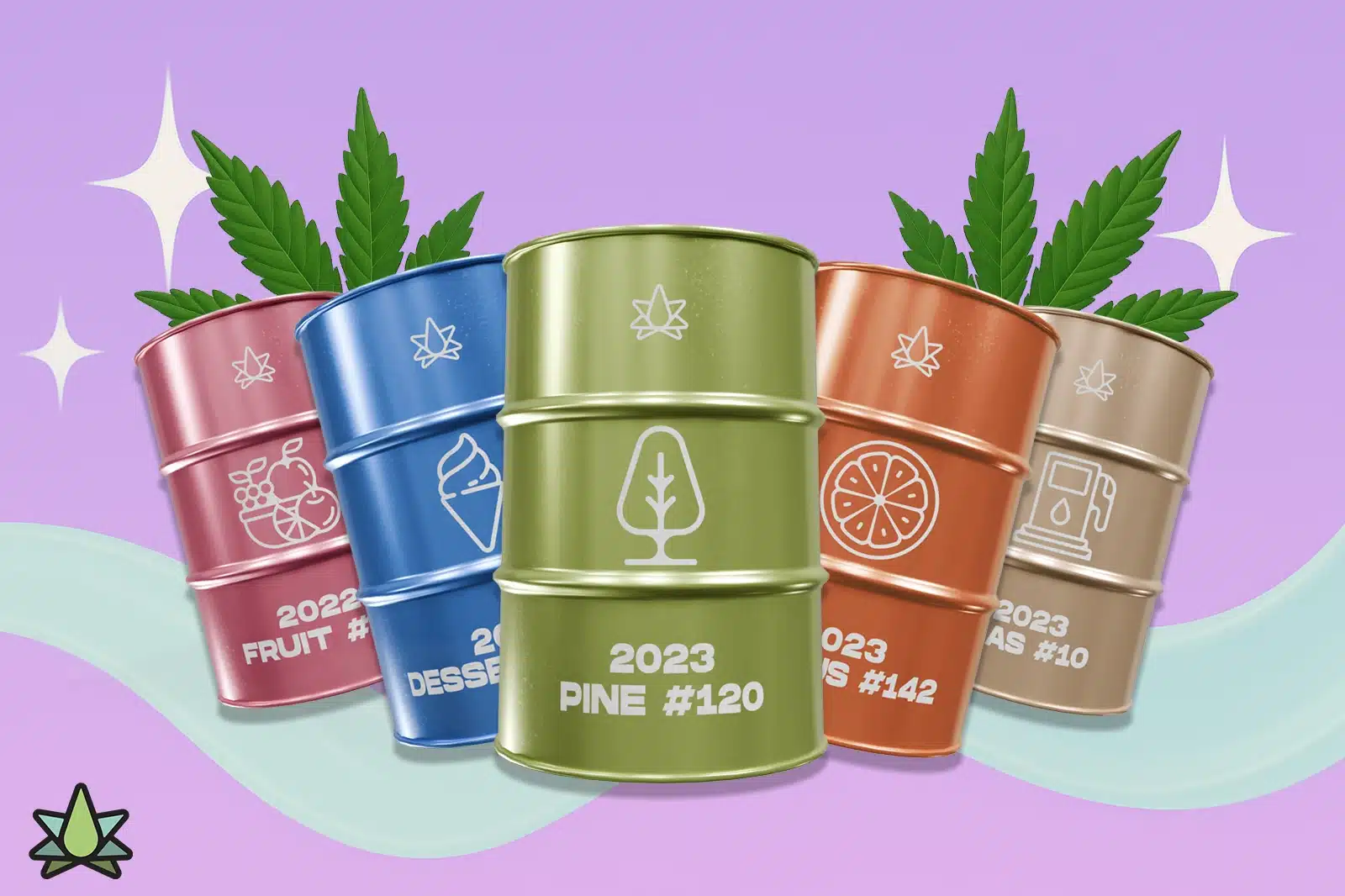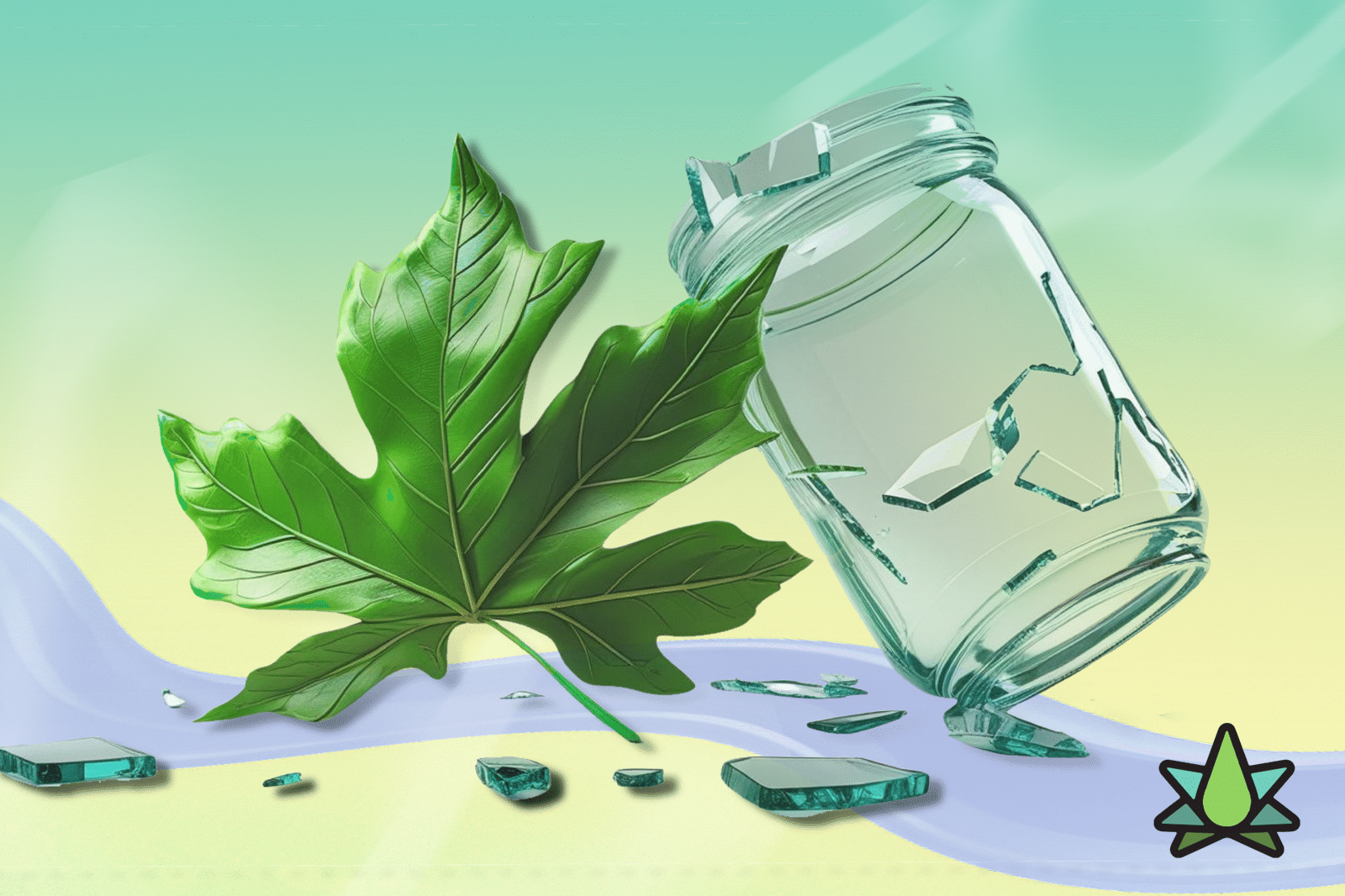Have you ever wondered why some strains lack that pungent, aromatic punch you crave? Cannabis typically has a distinctive scent. Behind the characteristic smell are compounds called terpenes. These aromatic compounds are also found in other plants like pine, citrus, lavender, etc.
Terpenes give cannabis a wide range of scents, from earthy and musky to fruity and floral. The specific aroma depends on the strain’s terpene profile. For example, myrcene is musky, limonene is citrusy, and pinene has a pine scent.
Generally, a pungent, complex aroma suggests a high-quality, terpene-rich cannabis product. Weak or absent scents may indicate improper curing, storage, or low-terpene genetics.
Besides giving strains their aroma, terpenes also synergize with cannabinoids to shape their effects. The aroma can provide clues about the expected experience, such as relaxation or invigoration.
So, if your cannabis has a bland or muted aroma, there are ways to enhance the aroma. By utilizing terpene-preserving techniques, you can achieve an authentic scent that helps your cannabis stand out.
Key Takeaways
- Terpenes influence cannabis effects, with scents like citrus (limonene) often linked to uplifting experiences and earthy tones (myrcene) to relaxation.
- Factors such as optimal growing conditions, proper harvesting, careful drying and curing, and terpene additives can enhance the scent of cannabis.
- Storing cannabis in airtight containers away from light, heat, and humidity preserves its aromatic profile and prevents terpene degradation.
Why Does Cannabis Aroma Matter?
Cannabis aroma matters for several reasons:
- Indicator of quality: A strong, complex scent suggests a high-quality, terpene-rich product. Weak or absent aromas indicate subpar cultivation, curing, or storage practices.
- Shapes the experience: Terpenes interact with cannabinoids to modulate the effects of cannabis. As such, the aroma provides clues about the potential experience, such as relaxation or invigoration.
- Influences preferences: Many consumers and patients choose strains based on their scents, associating certain aromas with desired effects or experiences.
- Competitive advantage: In a crowded market, cannabis products with superior aroma stand out and attract discerning consumers. A pungent, authentic scent can be a key differentiator.
- Enhances enjoyment: For many, the act of smelling cannabis is a pleasurable part of the consumption ritual. A robust, appealing aroma enhances the overall sensory experience.
Evidently, preserving cannabis aroma is not just about sensory pleasure – it’s also a marker of quality, a driver of consumer preference, and a potential competitive edge.
How to Improve Cannabis Aroma
Enhancing the smell of cannabis involves a multi-faceted approach, from cultivation to post-harvest processing. Here are some considerations to keep in mind:
- Choose terpene-rich genetics: Start with strains with pungent, complex terpene profiles. Some cultivars are naturally more aromatic than others.
- Optimize growing conditions: Light, temperature, humidity, and nutrients influence terpene production. Dial in these variables to maximize aroma.
- Harvest at peak aroma: Timing is critical. Harvest when trichomes are milky white and the scent is most pungent to capture peak terpene content.
- Dry and cure properly: Drying and curing preserve and develop aroma. Dry slowly in a dark, cool environment. Cure for at least 2-4 weeks in airtight containers, burping regularly.
- Preserve terpenes in processing: Use gentle extraction methods, such as solventless techniques, to maintain terpene profiles. Avoid high temperatures that can degrade terpenes.
- Store correctly: Airtight containers in a cool, dark place prevent terpene degradation. Avoid exposure to heat, light, and humidity.
- Supplement with terpenes: Natural, cannabis-derived terpene additives can restore or enhance the aroma of flower, concentrates, and infused products. Ensure the terpenes are pure and authentic.
By focusing on terpene preservation and expression from seed to sale, growers and processors can maximize the aromatic potential of their cannabis products.
Common Types of Cannabis Aromas
Cannabis strains offer a diverse palette of scents. Here are some of the most common aroma categories you’ll encounter:
- Skunky or pungent: These strains have a strong, musky odor reminiscent of a skunk’s spray. The scent is often associated with high-THC strains and can be quite polarizing – some find it off-putting, while others love its potency.
- Earthy or musky: Imagine the smell of fresh soil or damp wood. Earthy strains have a grounding, natural aroma that is subtly sweet or spicy. These scents are often linked to indica-dominant strains for relaxation.
- Fruity (citrus, berry, tropical): Fruity strains burst with the scents of ripe oranges, lemons, strawberries, or mangoes. These uplifting, mouthwatering aromas are often associated with sativa-dominant strains that provide energizing effects.
- Floral or herbal: These strains feature delicate floral notes like lavender or rose or herbaceous scents like sage or tea. Their aromas are often described as soothing, making them popular for stress relief.
- Diesel or chemical: Diesel strains are defined by pungent, gasoline-like scents. The aroma is often sharp and sour, with an underlying sweetness. These potent scents are associated with high-THC strains known for their cerebral effects.
You’ll find a wide range of scent notes within each category, making each strain unique. Exploring different aroma profiles is part of the joy of discovering your perfect cannabis match.
Where Does Cannabis Aroma Come From?
Cannabis aroma comes from terpenes, the aromatic compounds found in the plant’s resin glands or trichomes. These tiny, mushroom-shaped structures coat the buds and leaves, giving each strain its distinctive scent.
Terpenes evolved to protect the plant from predators and attract pollinators. They synergize with cannabinoids like THC and CBD to shape the effects and therapeutic benefits of cannabis. Several factors influence a strain’s terpene profile and aroma intensity:
- Genetics: A strain’s genetic makeup determines its potential terpene profile. Some cultivars are naturally more pungent than others.
- Growing conditions: Light, temperature, humidity, and nutrients affect terpene production. Optimal conditions maximize aroma.
- Harvesting: Timing is key. Harvesting at peak trichome ripeness captures the most robust terpene profile.
- Curing: Proper curing preserves and develops aroma by allowing chlorophyll to break down and terpenes to mature.
- Storage: Airtight containers in a cool, dark place prevent terpene degradation from heat, light, and humidity exposure.
While a strain’s genetics set the stage for its aroma potential, growers and processors must create the ideal conditions for terpene expression. Even the most pungent cultivars will yield a lackluster aroma if mishandled.
Fortunately, advances in cultivation techniques, post-harvest processing, and terpene isolation have made it easier than ever to maximize and maintain cannabis aroma from seed to sale.
How to Make Cannabis Smell Better
You can enhance the aroma of cannabis by optimizing your cultivation, processing, and storage practices. Here are some proven strategies to help:
1. Choose Aroma-Enhancing Nutrients
During the flowering stage, feed your plants nutrients that boost terpene production. Look for formulas high in sulfur, phosphorus, and potassium. These elements are the building blocks for terpenes and significantly improve aroma.
Avoid over-fertilizing with nitrogen, as this can lead to leafy, low-terpene buds. Instead, focus on providing the optimal balance of nutrients for each growth stage. Supplement with micronutrients like magnesium and calcium, which also influence terpene synthesis.
2. Optimize Growing Conditions
Dial in your growing environment to maximize terpene development. Provide plenty of light during flowering to support terpene synthesis. Maintain a comfortable temperature range between 65-80°F (18-26°C) and avoid extreme fluctuations. Use high-quality LED or HPS lighting systems that emit the ideal light for flowering.
Ensure good airflow and maintain moderate humidity levels to prevent mold and mildew, which can degrade aroma. Avoid stressing the plants by overwatering, underwatering, or pest damage to boost terpene production.
Monitor the grow room’s climate closely. Adjust lighting, temperature, humidity, and airflow as needed to create the optimal conditions for terpene expression.
Keep relative humidity between 40% and 50% during flowering to prevent moisture-related issues. Install fans and ventilation systems to ensure proper air circulation and prevent stagnant, odor-trapping pockets.
Regularly inspect your plants for signs of stress or deficiencies. Address any issues promptly to maintain the crop’s health and aroma.
Remember, even the most terpene-rich strains won’t reach their full aromatic potential without the right growing conditions. So, create the ideal environment for your plants to maximize their natural aroma expression.
3. Harvest at Peak Aroma
Timing your harvest is critical for capturing peak aroma. Wait until the trichomes turn milky white to amber, indicating maximum terpene concentration. Regularly check the scent of your buds as they mature.
Harvesting too early can result in a weak, underdeveloped aroma, while waiting too long can degrade terpenes as the buds overripen. Find the sweet spot where the scent is most pungent and appealing.
4. Dry and Cure Properly
Proper drying and curing are essential for preserving and enhancing cannabis aroma. Hang your trimmed buds to dry in a cool, dark place with good airflow. Aim for a slow drying process over 7-14 days to avoid losing terpenes to evaporation.
Once your buds are dry, cure them in airtight glass jars for at least 2 weeks. Burp the jars daily to release moisture and allow the aroma to develop. Proper curing preserves terpenes and creates a smoother, more pungent scent.
5. Use Aroma-Enhancing Additives
If your cannabis lacks aroma even after following best practices, consider natural additives to restore or enhance the scent. Cannabis-derived terpenes are an excellent option.
These concentrated terpene oils are extracted from the plant and added to flower, concentrates, or infused products to boost aroma. Use pure, strain-specific terpenes that match your desired scent profile.
Final Thoughts
The aroma of cannabis generally sets the standard for quality and consumer appeal. Healthy, unstressed plants produce the most pungent, complex terpene profiles. To this end, proper cultivation, harvesting, and storage techniques protect and enhance terpene production.
At the same time, carefully extracted terpenes can also be used to restore or amplify the aroma profile. Our Fresh Never Frozen® terpenes from Terpene Belt Farms are cannabis-derived, authentic, premium quality, and contain zero cannabinoids.
They are produced from plants harvested at peak ripeness and processed within minutes to preserve everything that makes California’s cannabis world-renowned. We provide a scalable supply chain and power formula standardization for the industry’s top brands.
We also offer NEU bags to increase the terpene content in cured material. When introduced into a bag with cured material, the oil in these innovative terpene infusion packs moves from the higher terpene concentration pack into the lower terpene concentration cured material until an equilibrium is reached.
Get in touch today and power your cannabis products with all-natural, 100% pure hemp terpenes. With wholesale bulk products available across 10 flavor profiles, our breadth and depth can not be matched.
Check out our collection of Fresh Never Frozen® terpenes.
Frequently Asked Questions
Why Does My Cannabis Have Little/No Smell?
It could be due to improper curing, poor storage, low-terpene genetics, or environmental stress during cultivation.
How Can I Make My Cannabis Smell Stronger?
Use terpene-rich strains, optimize growing conditions, harvest at peak aroma, dry and cure properly. You could use cannabis-derived terpenes, too.
What Are the Best Nutrients to Enhance Aroma?
Sulfur, phosphorus, and potassium help boost terpene production. However, excess nitrogen could cause leafy, low-aroma buds.
How Do Terpenes Affect My Cannabis Experience?
Terpenes interact with cannabinoids to influence the effects and experience—a phenomenon widely referred to as the entourage effect.
Reference
Ferber, S. G., Namdar, D., Hen-Shoval, D., Eger, G., Koltai, H., Shoval, G., Shbiro, L., & Weller, A. (2020). The “entourage effect”: Terpenes coupled with cannabinoids for the treatment of mood disorders and anxiety disorders. Current Neuropharmacology, 18(2), 87–96. https://doi.org/10.2174/1570159×17666190903103923


